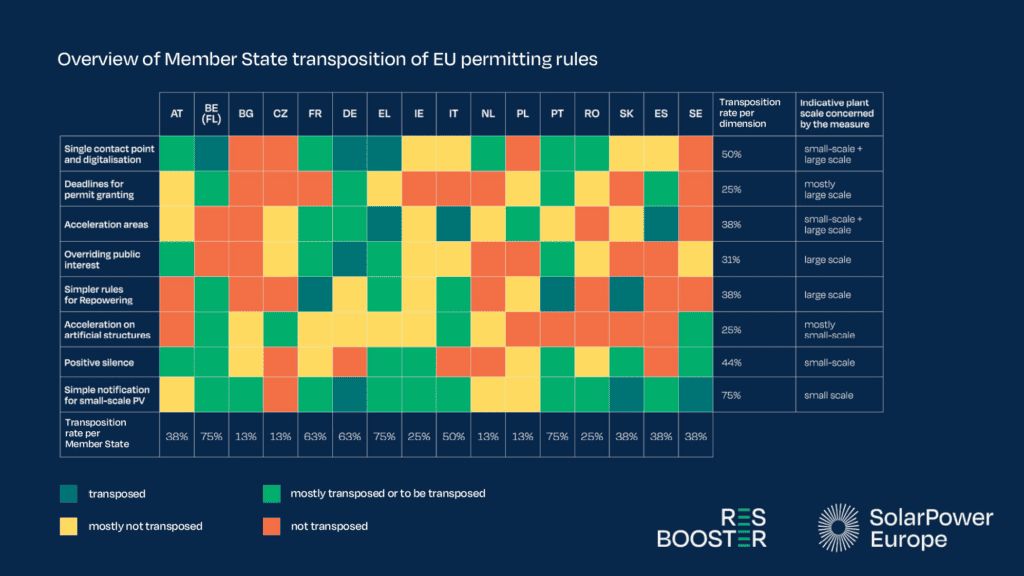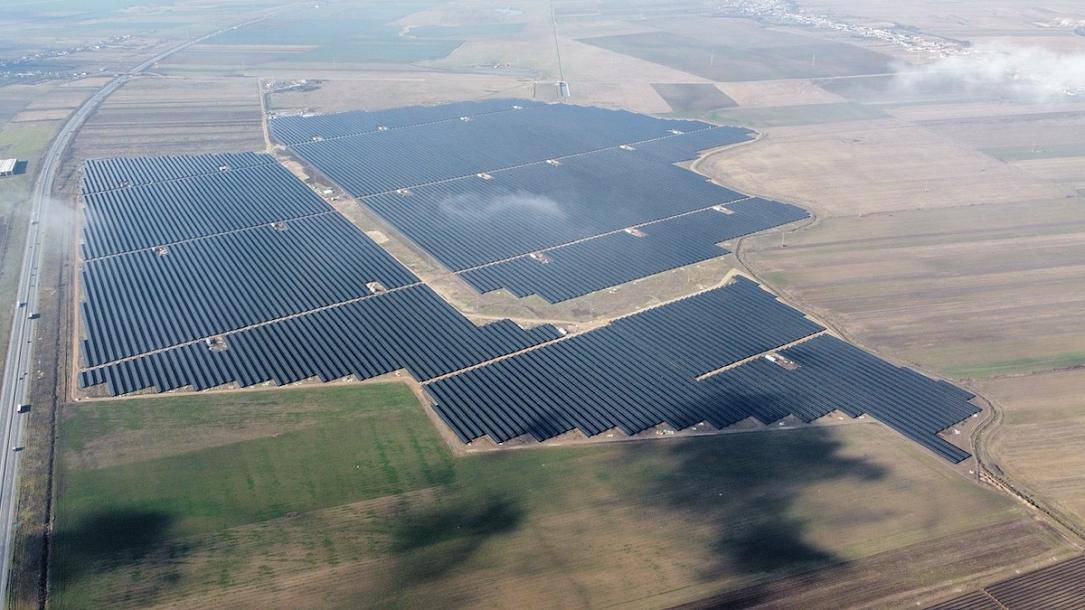Romania is undergoing a significant expansion in solar power within its broader energy transition framework, bolstered by European funding and legal reforms. This upsurge has prompted investments across the spectrum, from individual households as prosumers to utility-scale facilities, with local government units emerging as a significant segment for development up to the county level. Alongside solar, some localities are exploring geothermal energy prospects.
European solar power trends
The cumulative solar capacity within the European Union (EU) has reached 263 Gigawatts (GW) in 2023, marking a 27% increase from the previous year’s total of 207 GW, as per the data provided in the European Market Outlook for Solar Power 2023-2027 by SolarPower Europe.[1] This substantial growth is attributed primarily to the residual effects of the energy crisis and a backlog of installations from 2022, with activity tapering off towards the latter part of the year. The report projects a slowdown in the growth rate to 11% in 2024, anticipating an addition of 62 GW of new solar power capacity across Europe.
The year 2023 saw an addition of 55.9 GW of new solar capacity, effectively enabling nearly 17 million more European households to utilize solar energy. This expansion nearly achieved the 60 GW annual installation target posited by the International Energy Agency (IEA) to counterbalance the phasing out of Russian gas imports.
Despite these record-breaking installations, SolarPower Europe emphasizes that the current pace of solar adoption needs to accelerate to meet the 70 GW annual average installation rate required to achieve the EU’s 2030 solar energy targets. Walburga Hemetsberger, CEO of SolarPower Europe, underscores the critical need for continued policy support and action, cautioning against complacency as the decade progresses.
In the country-specific breakdown of solar capacity additions since the onset of 2023, Germany leads the European nations with an installation of 14.1 GW of new solar capacity. Spain follows as the second-highest with 8.2 GW, with Italy (4.8 GW), Poland (4.6 GW), and the Netherlands (4.1 GW) rounding out the top five contributors. This distribution highlights the uneven yet significant strides being made across the continent in harnessing solar energy, reflecting a collective move towards renewable energy sources and a more sustainable energy future.
Source: SolarPower Europe EU Market Outlook for Solar Power 2023-2027
The case of Romania
The 1 GW of newly installed solar capacity in Romania this year marks a 308 percent increase over the capacity added in 2022. The cumulative distributed and utility-scale solar capacity of the nation has surpassed 2.85 GW in 2023, producing in excess of 2.5 TWh or almost 5% of the overall power generation.[2]
Recent sector analyses reveal a substantial interest among Romanian homeowners in detached houses, with over 50% considering the acquisition of photovoltaic systems in 2023. This trend is evidenced by a tenfold increase in the demand for photovoltaic panels in 2022 compared to the previous year, aligning with European renewable energy initiatives and financial incentives for the green transition.[3]
To facilitate this shift towards renewable energy, Romanians have access to funding through several programs, including the National Recovery and Resilience Plan, the Modernization Fund managed by the Ministry of Energy, and Repower EU managed by the Ministry of Investments and European Funds.[4] Among these, the “Green House” program has been particularly popular, offering substantial grants for solar panel installations. Despite this aid, many individuals still face the necessity of initial full payments, with expert projections indicating a return-on-investment period of approximately 4-5 years.
Regulatory needs
George Niculescu, President of the National Energy Regulatory Authority (ANRE), recently advocated for the regulation of photovoltaic panel installations by prosumers, suggesting the need for implementing thresholds based on individual consumption needs and local area requirements. The rationale behind this proposition is the growing trend among prosumers to install photovoltaic panels that produce more electricity than they consume, leading to potential imbalances in the power network.
While the primary role of prosumers is to enhance energy system efficiency and reduce electricity and gas bills, particularly during times of high energy costs, some individuals have been leveraging photovoltaic systems as a means for profit generation. The current energy legislation allows for the feeding of surplus energy back into the grid, with prosumers receiving compensation for every kilowatt-hour produced. This mechanism has transformed solar panel ownership into a profitable endeavour for some.
However, the absence of regulatory limits on production capacity and installation could pose risks to the integrity and efficiency of the aging electricity grid, which is already under pressure and awaiting modernization and investment, as outlined in the National Recovery and Resilience Plan (PNRR). ANRE’s data confirms that prosumers are legally permitted to sell the surplus electricity to suppliers, provided the network’s capacity allows it.[5] As such, establishing parameters for photovoltaic installations is seen as a crucial step in maintaining network stability and ensuring the dual objectives of energy efficiency and grid reliability are met. In this sense, there exist European laws that are yet to be transposed by Romania.
The country is already on the good track of reducing bureaucracy and simplifying procedures for installation, signalling not only the intention of incentivizing solar panel adoption, but also the ability to listen to citizen and corporate needs. In June 2023, for instance, a new law was introduced in this regard.[6]

Future prospects: European funding and the country’s green objectives
The Green House Photovoltaic Programme, administered by Romania’s Environmental Fund Administration (AFM), was temporarily suspended in September following a judicial decision from the Court of Appeal of Oradea.[7] The suspension came after litigation involving a company denied approval for panel installation. Consequently, approximately 90,000 participants in the program await the mounting of solar panels on their residences. In light of these developments, the Minister of the Environment, Mircea Fechet, has assured an extension of all relevant deadlines to ensure no participant forfeits their funding.
In the broader context of renewable energy in Romania, the country operates more than 14 significant wind farms and 21 photovoltaic parks. Notably, a substantial private investment is set to establish the largest photovoltaic park in Europe in Arad, boasting a capacity of 1000 megawatts across 100 hectares, indicative of Romania’s commitment to expanding its renewable energy infrastructure.
Current production from wind plants is approximately 3,000 megawatts annually, with photovoltaic plants contributing around 1,500 megawatts, and hydroelectric sources providing the remainder of over 6,000 megawatts. Projections from the National Strategy and Forecasting Commission suggest a substantial average annual increase of 18.9% in photovoltaic electricity production between 2024 and 2026.[8]
Amid global energy market challenges, notably those arising from the Russian invasion of Ukraine, the European Commission has initiated the REPowerEU plan. This initiative aims to bolster EU states’ energy savings, clean energy production, and supply diversification. Romania is set to benefit significantly from REPowerEU, with an allocation of 1.4 billion Euros to hasten the green transition and foster renewable energy investments. By 2030, the country aspires to generate 30% of its electricity from green sources.[9]
Furthering these objectives, Bucharest has submitted a revised National Recovery and Resilience Plan alongside the RePowerEU plan to the European Union[10], outlining comprehensive measures including the procurement of photovoltaic panels, energy storage batteries, and other innovative energy solutions. These steps underscore Romania’s strategic approach to enhancing its energy autonomy, reducing consumption, and embracing a sustainable energy future.
After the COP28 summit
Romania has set an ambitious target to install over 8 Gigawatts of solar energy capacity by 2030, which is anticipated to constitute 24% of its gross final electricity consumption from renewable sources. This objective was announced by President Klaus Iohannis during his speech at the COP28 summit, coinciding with Romania’s accession to the International Solar Alliance.
President Iohannis expressed his conviction that membership in the Alliance would foster broader and more profound cooperation with India, where the Alliance’s Secretariat is based, as well as with other nations committed to expediting climate change mitigation efforts. He underscored that heightened climate ambition correlates with enhanced economic opportunities and benefits for citizens, reflecting a holistic approach to addressing climate change while promoting sustainable development:[11] “By 2030, Romania aims to install a solar energy capacity of over 8 Gigawatts, representing 24% of the gross final consumption of electricity from renewable sources. Romania’s commitment to increase its installed solar energy capacity is fully aligned with the EU Strategy on Solar Energy and will contribute to the implementation of the Agreement in Paris.”
Case study: Timsoara’s project
Timișoara, the principal city in the western region and the administrative centre of Timiș county, is among the municipalities driving solar power projects for internal use.[12] The city has embarked on constructing a 5.6 MW photovoltaic unit, strategically located near the Freidorf industrial area. This initiative forms a part of Timișoara’s broader strategy to adopt renewable energy sources and diminish pollution levels. The unit is anticipated to generate approximately 7.8 GWh annually.
Dominic Fritz, the Mayor of Timișoara, articulated the city’s goal to offset nearly two-thirds of its public lighting electricity consumption through this solar park. The transition towards renewable energy is seen as a crucial step in Timișoara’s journey to becoming a greener city. The photovoltaic facility will predominantly utilize monocrystalline panels, chosen for their efficiency in cooler and cloudier climates.
The city also highlighted that this solar power project is expected to receive European Union funding, contributing towards the broader objectives of enhancing electric public transport, improving energy efficiency in public institutions, and modernizing the heating network.
The total investment for this photovoltaic system is estimated at EUR 6.5 million, inclusive of value-added tax, with a stipulated construction timeline of 12 months post the issuance of the final permit. This venture reflects Timișoara’s commitment to renewable energy and sustainable urban development, positioning it within a growing cohort of Romanian municipalities leading the charge in solar power adoption.
References
-
https://www.solarpowereurope.org/insights/outlooks/eu-market-outlook-for-solar-power-2023-2027 ↑
-
https://www.solarpowereurope.org/insights/outlooks/eu-market-outlook-for-solar-power-2023-2027 ↑
-
https://www.balcanicaucaso.org/eng/Areas/Romania/Romania-all-crazy-about-photovoltaics-227843 ↑
-
https://economedia.ro/caciu-anunta-un-nou-program-din-2024-care-va-include-acordarea-de-vouchere-de-50-000-de-lei-pentru-achizitia-de-panouri-solare-si-pentru-stocarea-energiei-produse-din-repowereu.html ↑
-
https://anre.ro/wp-content/uploads/2023/09/Situatia-privind-promovarea-energiei-electrice-produse-de-capacitati-electrice-din-surse-regenerabile-apartinand-prosumatorilor-la-data-de-31.07.2023.pdf ↑
-
https://www.pv-magazine.com/2023/06/16/romania-removes-legal-barriers-to-development-of-large-scale-solar/ ↑
-
https://seeenergy.news/romania-photovoltaics-are-growing-rapidly/ ↑
-
https://www.balcanicaucaso.org/eng/Areas/Romania/Romania-all-crazy-about-photovoltaics-227843 ↑
-
https://balkangreenenergynews.com/eu-approves-repowereu-green-energy-projects-submitted-by-greece-romania/ ↑
-
https://commission.europa.eu/business-economy-euro/economic-recovery/recovery-and-resilience-facility/country-pages/romanias-recovery-and-resilience-plan_en ↑
-
https://www.romania-insider.com/cop28-romania-president-solar-energy-2023 ↑
-
https://balkangreenenergynews.com/city-of-timisoara-catches-romanias-solar-wave-with-own-utility-scale-project/ ↑





